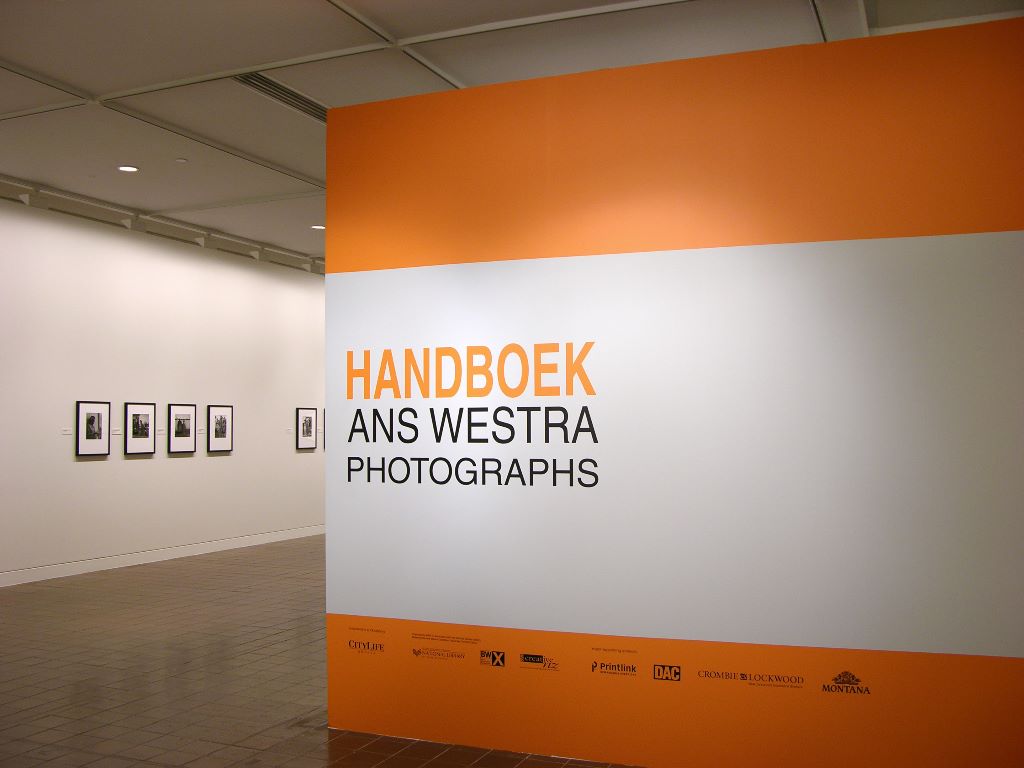—

exhibition Details
Ans Westra is one of New Zealand's most celebrated photographers, with a career spanning almost 50 years. She is known particularly for her photographs of Mäori, the 1970s counterculture and protest action in general. Much of her earlier work was produced for publications such as the Department of Mäori Affairs journal Te Ao Hou and various journals and bulletins published by the School Publications Branch of the Department of Education. She has also produced four major photographic books.
Handboek: Ans Westra Photographs is a large-scale survey exhibition containing work selected from the approximately 48,000 negatives that reside in the Westra archive at Turnbull Pictures in the National Library. Westra's recurring themes of Mäori social, cultural and political life are well represented in pictures made across the last five decades of the 20th century. Interspersed amongst them are photographs of subjects less commonly associated with Westra, work place studies for example, which are often rendered in a manner somewhat removed from her normal style. In addition to these striking individual photographs, many of which form part of larger wholes, the exhibition provides samples from specific projects of particular historical or personal significance (Washday at the Pa and Washday at the Pa Revisited; the Parakino photographs). Handboek, as its Dutch title suggests, is not only a concise guide to Westra's photographic journey but also a form of visual writing of New Zealand history, with a particular emphasis on Mäori during the same period.
Westra's career is remarkable in many respects. When she began, photography in New Zealand, whether conceived as art or social documentary, was barely visible. During the 1970s she was involved in the broad movement to establish photography as a serious art form, a crusade lead by PhotoForum and its eponymous house journal, and her work was featured in many of the groundbreaking photography exhibitions of the time. In the mid-1980s her contribution to the development of social documentary photography was acknowledged in the exhibition Witness to Change (1985), where her work represented 'the 1960s'. Yet, somewhat ironically, this belated celebration of her contribution to New Zealand modernist photography was short lived, as Westra's work quickly came under the scrutiny of an emergent postmodern 'deconstruction' of documentary photography.
The cultural and political changes tracked through Westra's career are even more pronounced than the changes in photographic practice and in debates over representation. In the late 1950s and early 1960s, the reigning paradigm in New Zealand race relations was still assimilation (articulated as 'integration' in the 1961 Hunn Report). The critique of Washday of the Pa (1964), advanced by the Mäori Women's Welfare League and its supporters, fell within this paradigm in that it embraced a mainstream modernising direction for Mäori. Washday, a bulletin for primary schools published by the Department of Education, depicted a rural Mäori family living in a dilapidated house, at a time when many Mäori had moved to the cities and were living in closer proximity to pakeha. The League considered that Washday's images were not 'typical' of contemporary Mäori efforts to adapt to the demands of the modern world and that the book would have a detrimental effect on relations with pakeha. It was swiftly withdrawn from classrooms by order of the Minister of Education. By contrast, the mass mobilisations of the latter half of the 1970s, including the Mäori Land March of 1975, the occupation of Bastion Point, and the fallout of the 1981 Springbok tour protests - the kind of events which Westra was on hand to record - were all signs of a militant ethnic and cultural nationalism that was unsympathetic to Westra's photographic project for quite different reasons. Yet neither Washday in the 1960s, nor the pictures collected within Whaiora in 1985, can be reduced to a simple matter of controversy. Westra has never courted controversy, but has been unable to avoid it because of her highly visible way of working and the widespread dissemination of her photographs through publications.
Having weathered the storms of the 1980s interrogation of her mode of representation and her manner of deporting herself in culturally coded and public spaces, Westra now finds herself cast as a stubborn analogue survivor in a 'post-photographic' digital environment. It would, however, be a mistake to assume from this that her practice has remained static or has been overtaken by time and technology, or that it was even that simple to begin with. To give just one example, the colour photographs selected from the exhibition As Far North as You Can Go (2002) wittily deploy the holiday snap mode in a manner quite removed in tone from her classic black and white documentary work. Similarly, while there are images in Handboek that support a view of Westra as outsider, a classically detached objective documenter of people and events, this now standard view needs to give way to a more complex and nuanced one, which takes into account the variety of her projects. The making of Westra's photographic books for children, for example, has involved a negotiated relationship with her subjects, in some instances over an extended period of time. Furthermore, these projects, far from being examples of objective documentary, are highly crafted fictional or perhaps more accurately 'factional' narratives, frequently involving collaborations with novelists or poets.
- Date
- —
- Location
- Main Gallery
- Cost
- Free entry